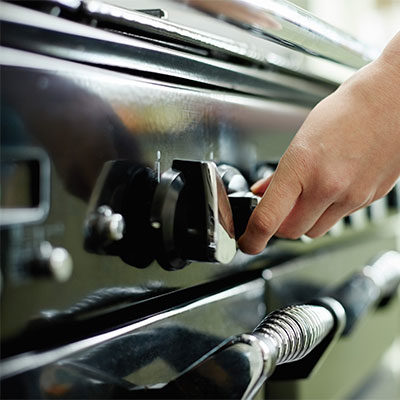Safety and Efficiency of Gas Appliances
When purchasing a new appliance, look for those that are not only energy efficient but designed to meet safety standards. You can typically identify certification of national safety standards by a label on the appliance itself or within the paperwork for the appliance.
Never attempt to install an appliance yourself. Most vendors have trained, qualified professionals on hand to install appliances to make sure they’re properly connected and vented.
Follow the manufacturer’s instructions for operation and care of your equipment. Most gas appliances must be vented properly and require fresh air to operate. Keep the area around gas appliances clear, especially from combustible materials.
Call a professional if there is any irregularity with your appliance, like overheating or the presence of soot around a burner.
Pilot Lights
Many modern appliances are electric ignition and do not have a constant burning pilot light. If your pilot light is out and you smell gas, leave the area and call the company emergency line at (540) 777-0623.
Water Heaters
Setting your water heater temperature too high can cause severe burns or scalding. Read the water heater instruction manual before setting it to a safe and efficient temperature.
CSST (Corrugated Stainless Steel Tubing)
Corrugated stainless steel tubing (CSST) is a flexible, stainless steel piping system used to supply natural gas in residential, commercial, and industrial structures. Standard CSST is coated with a yellow exterior plastic coating. If lightning strikes on or near a structure, there is risk it can travel through the structure’s gas piping system and cause a leak, and in some cases a fire. Since 2006, all manufacturer’s instructions have required direct-bonding and grounding of yellow CSST in new installations. A bonding connection install on a gas piping system, as with any metallic system within a house, will reduce the likelihood of electrical arcing to or from other bonded metallic systems in the structure, thus reducing the likelihood of arc induced damage.
What should I do if I find CSST?
- Inspect – If work has been performed on the gas piping system in your home or business since 1990, it’s possible that yellow CSST was installed but not to current installation requirements.
- Mitigate – If you find yellow CSST, it is strongly recommended that you contact a licensed electrician. The licensed electrician can make sure that your system is properly bonded.
Flexible Gas Connectors
In 1996, the Consumer Product Safety Commission (CPSC) issued a warning about flexible gas connectors made of corrugated, uncoated brass. These connectors were typically made before 1987 and were often used to connect gas ranges and clothes dryers. As the connectors age, they may crack or break, resulting in a gas leak, fire, or explosion. The CPSC recommends that any uncoated brass connector is replaced immediately by a new stainless steel connector or a new plastic-coated brass connector.
If your appliance has a flexible gas connector that has been in place since the time frame listed above, you should consider having it replaced. Do not attempt to move the equipment yourself to inspect it; contact a licensed professional to conduct an inspection.


